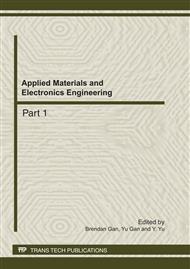p.561
p.565
p.569
p.575
p.580
p.585
p.589
p.593
p.597
Comparison of Mechanical Properties between Thai Orthodontic Elastics with Different Ammonia Contents and Commercial Orthodontic Elastics
Abstract:
Introduction: The most widely used preservative system for natural rubber latex to date is the ammonia-based system preventing spontaneous coagulation and putrefaction due mainly to bacteria contamination. Objectives: The study compared 2 types of Thai orthodontic elastics, produced from natural rubber latex with different ammonia contents with commercial orthodontic elastics in terms of initial extension force, residual force, force loss, swelling index, breaking strength and maximum displacement. Materials and Methods: Thai orthodontic elastics were developed from 2 types of natural rubber latex; low ammonia < 0.15% (Thai-L), and high ammonia not < 0.6% (Thai-H). The mechanical properties of Thai orthodontic elastics were compared with commercial elastics (Ormco). Mechanical properties were tested using a universal testing machine (Instron 5566). Data were analyzed by One-way ANOVA and Tukey’s test compared the measurements among groups. Results: Ormco had the highest initial extension force and showed significant differences with Thai-L and Thai-H. Thai-L had the highest residual force but showed no significant difference compared with Ormco. Thai-L had the lowest percent of force loss and showed significant differences with Thai-H and Ormco. Thai-L had lower force loss than Thai-H. For swelling index, Thai-L had the highest elasticity. For breaking strength and maximum displacement, both Thai elastics met the Australian Standard (AS) for breaking strength and maximum displacement, similar to Ormco elastics. Conclusion: All elastics met the specifications of the AS for breaking strength and maximum displacement. Thai-L had comparable properties with commercial orthodontic elastics in terms of mechanical properties. Thai-L had comparable properties with Ormco in terms of mechanical properties and may be developed for orthodontic purposes.
Info:
Periodical:
Pages:
580-584
Citation:
Online since:
October 2011
Price:
Сopyright:
© 2012 Trans Tech Publications Ltd. All Rights Reserved
Share:
Citation:


